- Home
- The Spring Garden
- Daffodils
Daffodils Signal the End of Winter
with Bright Cheer
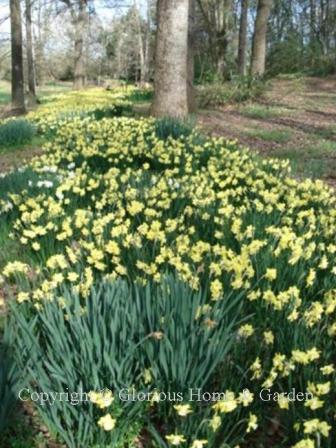 A "river" of daffodils.
A "river" of daffodils.Daffodils (Narcissus) are a must for the spring garden. I look forward with anticipation each spring as they begin to emerge from the ground. And they can be used in so many ways--in masses for a carpet of color, in small groups in the woodland garden, in a cutting garden to bring in for arrangements, in containers, or under deciduous trees where they will get sun until the tree leaves emerge. They are easy to grow, the clumps will increase in size and they are deer resistant. Plant narcissus bulbs in the fall, in full sun (preferably at least 6 hours a day) or dappled shade, in well-drained soil. After flowering, do not remove the foliage, or tie it in knots, but allow to die away naturally, the bulbs need the foliage to make food for next year's flowers. Scatter a little bulb food on the ground around the bulbs after blooming, lightly scratch it into the soil and water. Eventually, the clumps will get quite dense and begin to produce fewer flowers, then you will know that it is time to divide them. The best time to divide them is after the foliage turns brown, then you can dig the clump and separate the bulbs to replant. That's the nice thing about daffodils--they perennialize very well and eventually you will have quite a lot and you can share with friends or perhaps create a "river of daffodils" like the picture above.
It is fun to plant a few new ones each fall. There
are so many different types of daffodils that they have been officially placed
into 13 divisions. The descriptions and
criteria for each division below are from the American Daffodil Society. try some of each group for a variety of colors, shapes and bloom times.
Division 1: Trumpet Daffodils
Trumpets--One flower to a stem, corona (trumpet or cup) as long or longer than the perianth segments (petals).
Examples: Beersheba, Bravoure, British Gamble, Dutch
Master, Goblet, King Alfred, Lemon Glow, Marieke, Mount Hood, Pistachio, Spellbinder, Watch Up, W. P. Milner
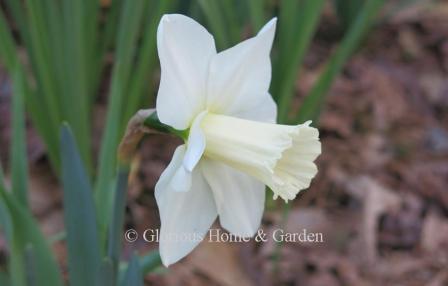 Narcissus 'Beersheba,' a trumpet daffodil.
Narcissus 'Beersheba,' a trumpet daffodil.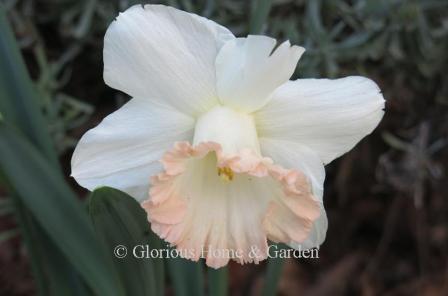 Narcissus 'British Gamble,' a trumpet daffodil.
Narcissus 'British Gamble,' a trumpet daffodil.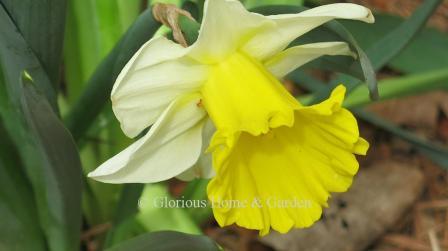 Narcissus 'Goblet,' a trumpet daffodil.
Narcissus 'Goblet,' a trumpet daffodil.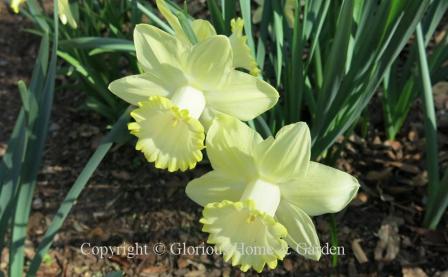 Narcissus 'Lemon Glow,' a trumpet daffodil.
Narcissus 'Lemon Glow,' a trumpet daffodil.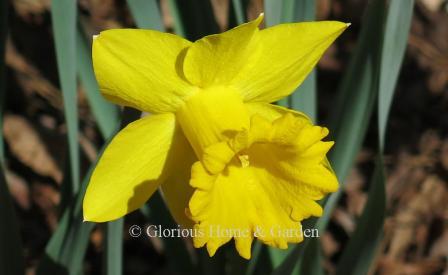 Narcissus 'Marieke,' a trumpet daffodil.
Narcissus 'Marieke,' a trumpet daffodil.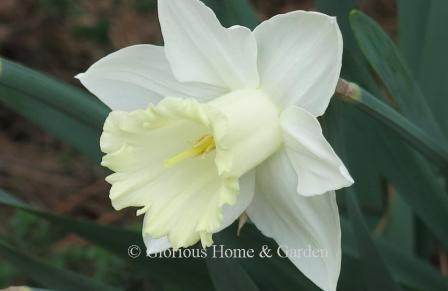 Narcissus 'Mount Hood,' a trumpet daffodil.
Narcissus 'Mount Hood,' a trumpet daffodil.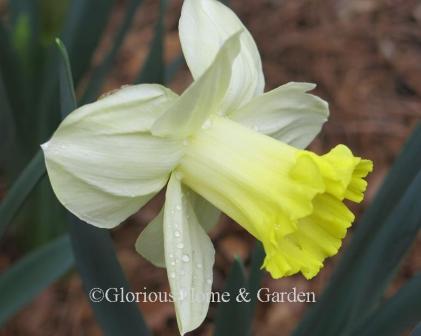 Narcissus 'Pistachio,' a trumpet daffodil.
Narcissus 'Pistachio,' a trumpet daffodil.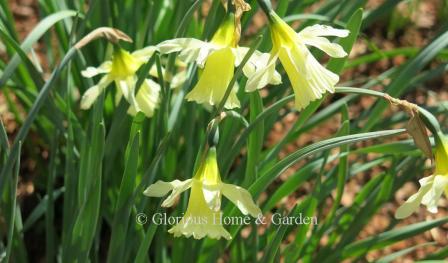 Narcissus 'W. P. Milner,' a miniature trumpet. daffodil
Narcissus 'W. P. Milner,' a miniature trumpet. daffodilDivision 2: Large-Cupped Daffodils
Large-Cupped Daffodils--One flower to a stem, corona (cup) more than one third but less than equal to the length of the perianth.segments (petals).
Examples: Avalon, Can Can Girl, Delibes, Fragrant Breeze, Flower Record, Fortissimo, Ice Follies, Perfect Lady, Pink Charm, Professor Einstein, Salome, Sound
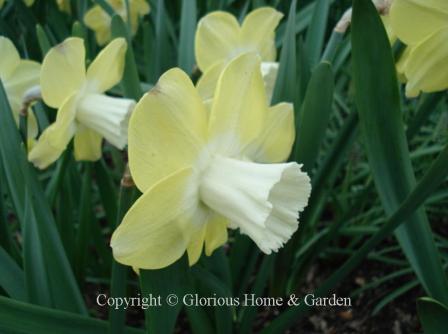 Narcissus 'Avalon,' a large-cupped daffodil.
Narcissus 'Avalon,' a large-cupped daffodil.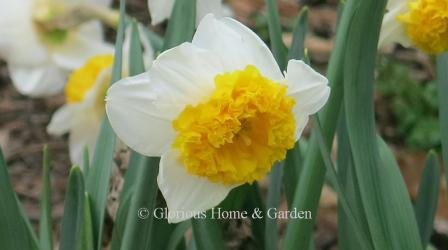 Narcissus 'Can Can Girl,' a large-cupped daffodil.
Narcissus 'Can Can Girl,' a large-cupped daffodil.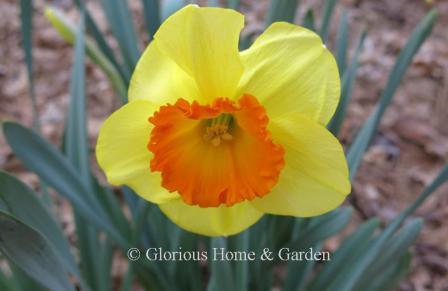 Narcissus 'Delibes,' a large-cupped daffodil.
Narcissus 'Delibes,' a large-cupped daffodil.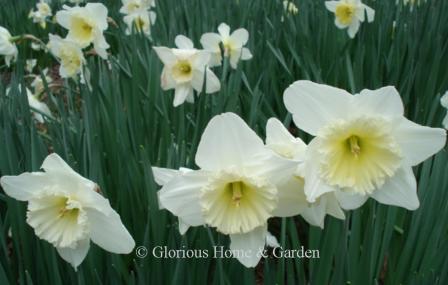 Narcissus 'Ice Follies,' a large-cupped daffodil.
Narcissus 'Ice Follies,' a large-cupped daffodil.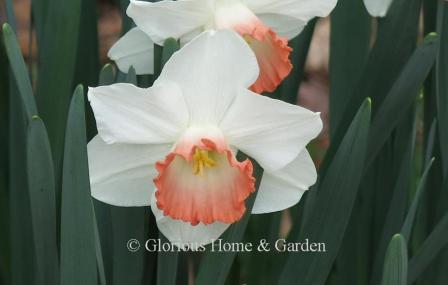 Narcissus 'Pink Charm,' a large-cupped daffodil.
Narcissus 'Pink Charm,' a large-cupped daffodil.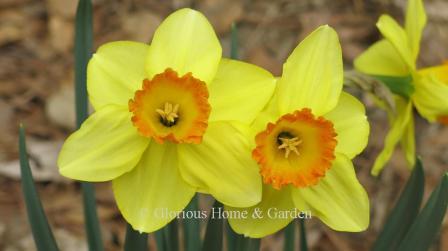 Narcissus 'Red Devon, a large-cupped daffodil.
Narcissus 'Red Devon, a large-cupped daffodil.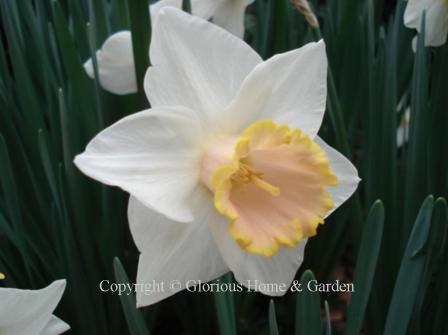 Narcissus 'Salome,' a large-cupped daffodil.
Narcissus 'Salome,' a large-cupped daffodil.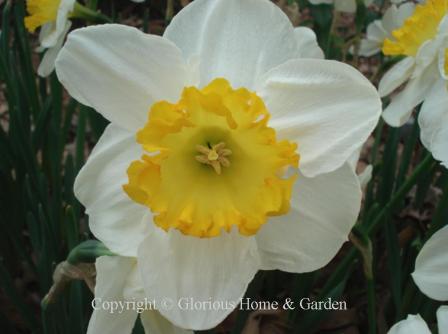 Narcissus 'Sound,' a large-cupped daffodil.
Narcissus 'Sound,' a large-cupped daffodil.Division 3: Small-Cupped Daffodils
Small-Cupped Daffodils-- One flower to a stem, corona (cup) not more than one third the height of the perianth segments (petals).
Examples: Altruist, Barrett
Browning, Falmouth Bay, Goose Green, Jamestown, Princess Zaide, Queen of the North, Ringtone, Royal Princess, Segovia, Sinopel, Xit
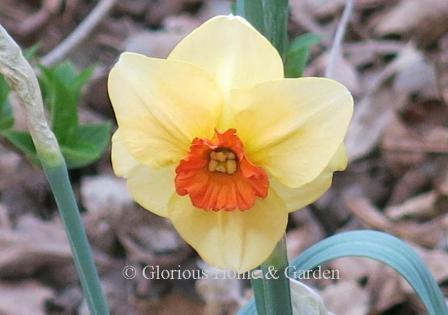 Narcissus 'Altruist,' a small-cupped daffodil.
Narcissus 'Altruist,' a small-cupped daffodil.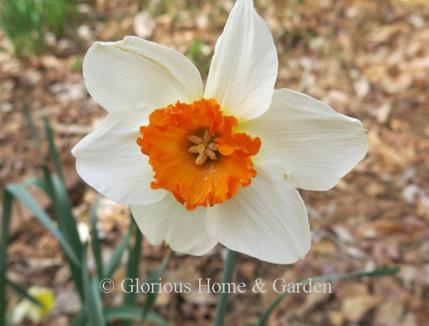 Narcissus 'Barrett Browning,'a small-cupped daffodil.
Narcissus 'Barrett Browning,'a small-cupped daffodil.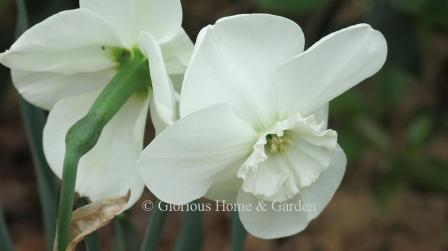 Narcissus 'Falmouth Bay,' a small-cupped daffodil.
Narcissus 'Falmouth Bay,' a small-cupped daffodil.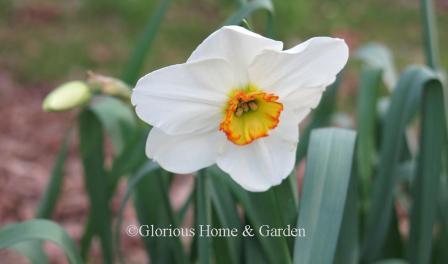 Narcissus 'Goose Green,' a small-cupped daffodil.
Narcissus 'Goose Green,' a small-cupped daffodil.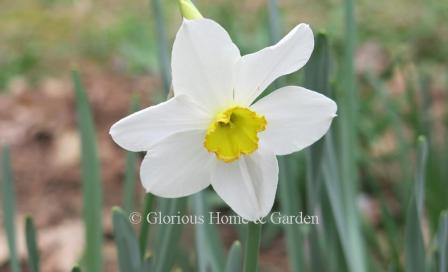 Narcissus 'Queen of the North,' a small-cupped daffodil.
Narcissus 'Queen of the North,' a small-cupped daffodil.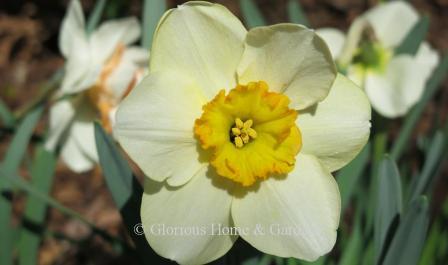 Narcissus 'Ringtone,' a small-cupped daffodil.
Narcissus 'Ringtone,' a small-cupped daffodil.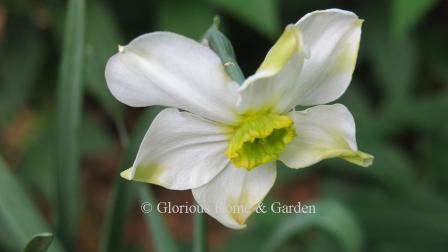 Narcissus 'Sinopel,' a small-cupped daffodil.
Narcissus 'Sinopel,' a small-cupped daffodil.Division 4: Double Daffodils
Double Daffodils-- Daffodils have a clustered cup, petals or both. There can be one or more flowers per stem.
Examples:
Cheerfulness, Delnashaugh, Erlicheer, Feu de Joie, Ice King, Irene Copeland, Replete, Rip van Winkle, Tahiti,
Wave, White Lion, Yellow Cheerfulness
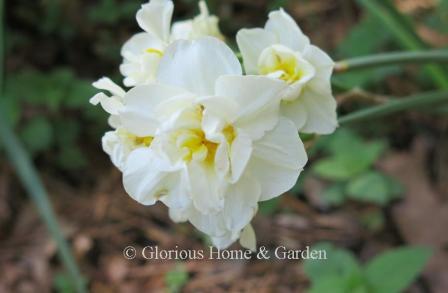 Narcissus 'Cheerfulness,' a double daffodil.
Narcissus 'Cheerfulness,' a double daffodil.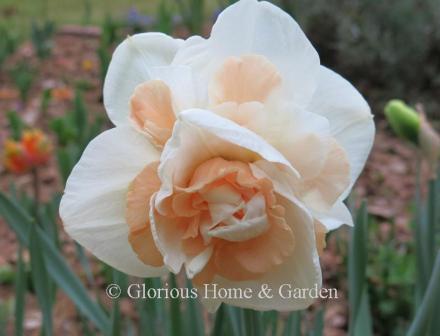 Narcissus 'Delnashaugh,' a double daffodil.
Narcissus 'Delnashaugh,' a double daffodil.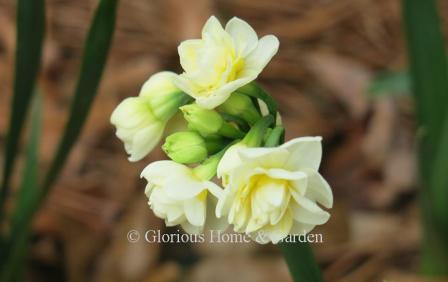 Narcissus 'Erlicheer,' a double daffodil.
Narcissus 'Erlicheer,' a double daffodil.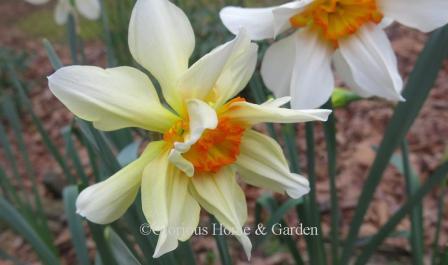 Narcissus 'Feu de Joie,' a double daffodil.
Narcissus 'Feu de Joie,' a double daffodil.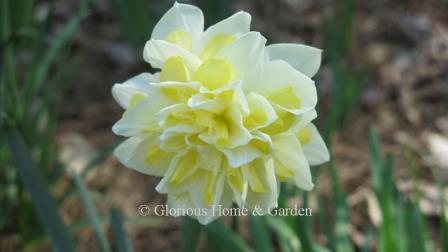 Narcissus 'Irene Copeland,' a double daffodil
Narcissus 'Irene Copeland,' a double daffodil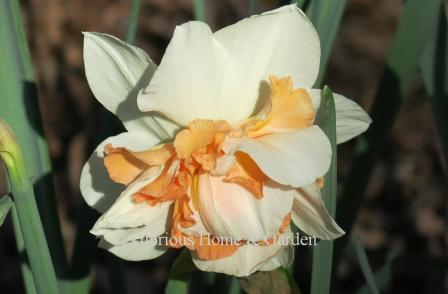 Narcissus 'Replete,' a double daffodil.
Narcissus 'Replete,' a double daffodil.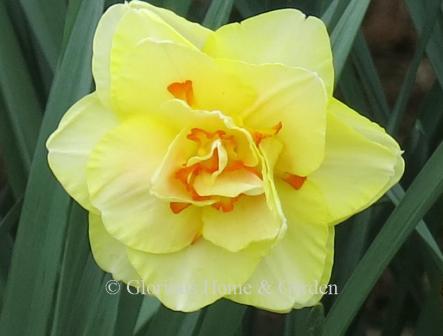 Narcissus 'Tahiti,' a double daffodil.
Narcissus 'Tahiti,' a double daffodil.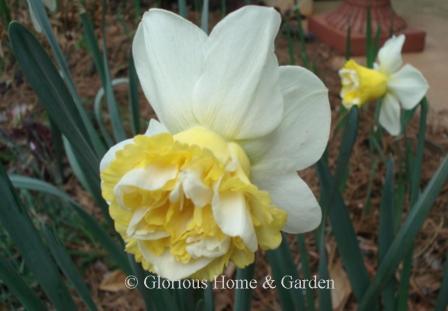 Narcissus 'Wave,' a double daffodil.
Narcissus 'Wave,' a double daffodil.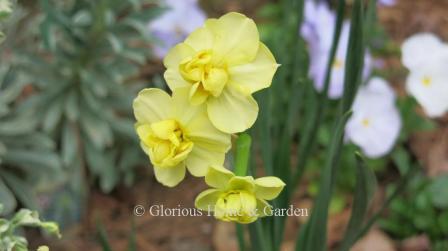 Narcissus 'Yellow Cheerfulness,'a double daffodil.
Narcissus 'Yellow Cheerfulness,'a double daffodil.Division 5: Triandrus Daffodils
Triandrus Daffodils-- Usually more than one flower to a stem, head drooping, perianth segments often reflexed and of silky texture. There are usually two or more blooms per stem.
Examples: Hawera, Ice Wings, Lemon Drops, Liberty Bells, Petrel, Stint, Thalia
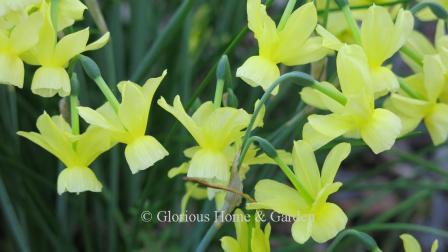 Narcissus 'Hawera,' a triandrus daffodil.
Narcissus 'Hawera,' a triandrus daffodil.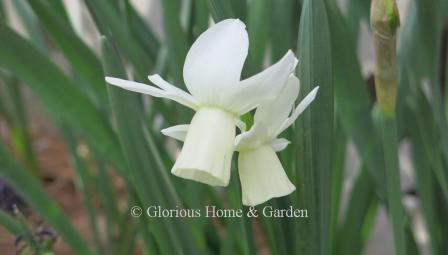 Narcissus 'Ice Wings,' a triandrus daffodil.
Narcissus 'Ice Wings,' a triandrus daffodil.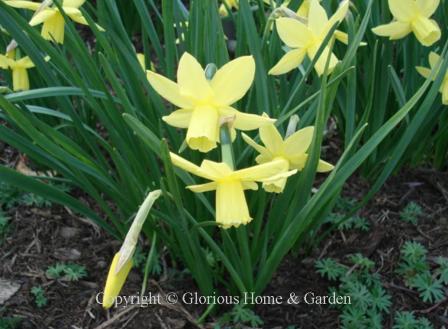 Narcissus 'Liberty Bells,' a triandrus daffodil.
Narcissus 'Liberty Bells,' a triandrus daffodil.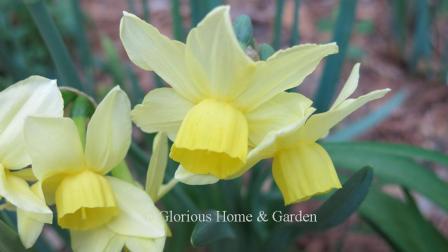 Narcissus 'Stint,' a triandrus daffodil.
Narcissus 'Stint,' a triandrus daffodil.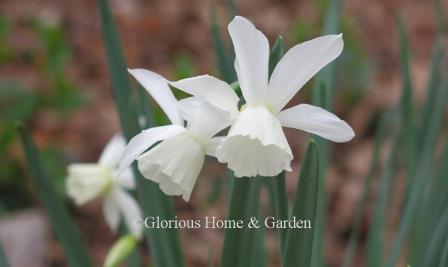 Narcissus 'Thalia,' a triandrus daffodil.
Narcissus 'Thalia,' a triandrus daffodil.Division 6: Cyclamineus Daffodils
Cyclamineus Daffodils-- One flower to a stem, perianth significantly reflexed and corona straight and narrow. flower at an acute angle to the stem, with a very short pedicel (neck).
Examples: February
Gold, Jack Snipe, Jetfire, Peeping Tom, Rapture, Snipe, Winter Waltz, Wisley
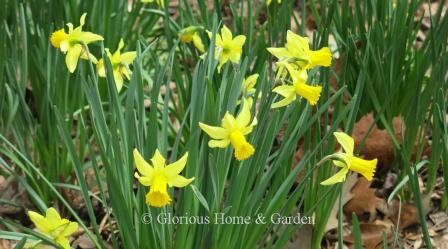 Narcissus 'February Gold,' a cyclamineus daffodil.
Narcissus 'February Gold,' a cyclamineus daffodil.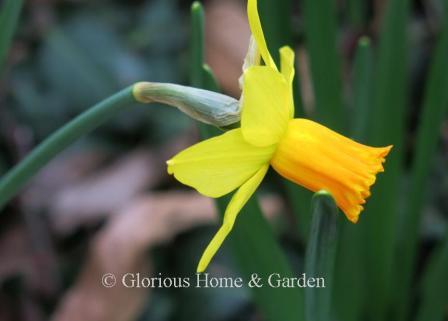 Narcissus 'Jetfire,' a cyclamineus daffodil.
Narcissus 'Jetfire,' a cyclamineus daffodil.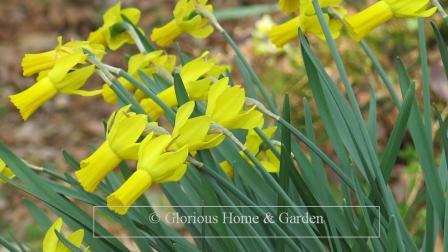 Narcissus 'Rapture,' a cyclamineus daffodil.
Narcissus 'Rapture,' a cyclamineus daffodil.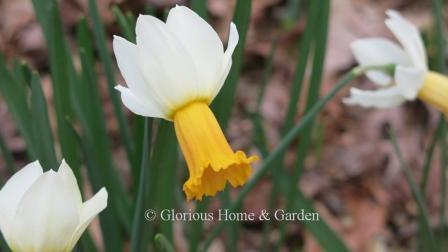 Narcissus 'Winter Waltz,' a cyclamineus daffodil.
Narcissus 'Winter Waltz,' a cyclamineus daffodil.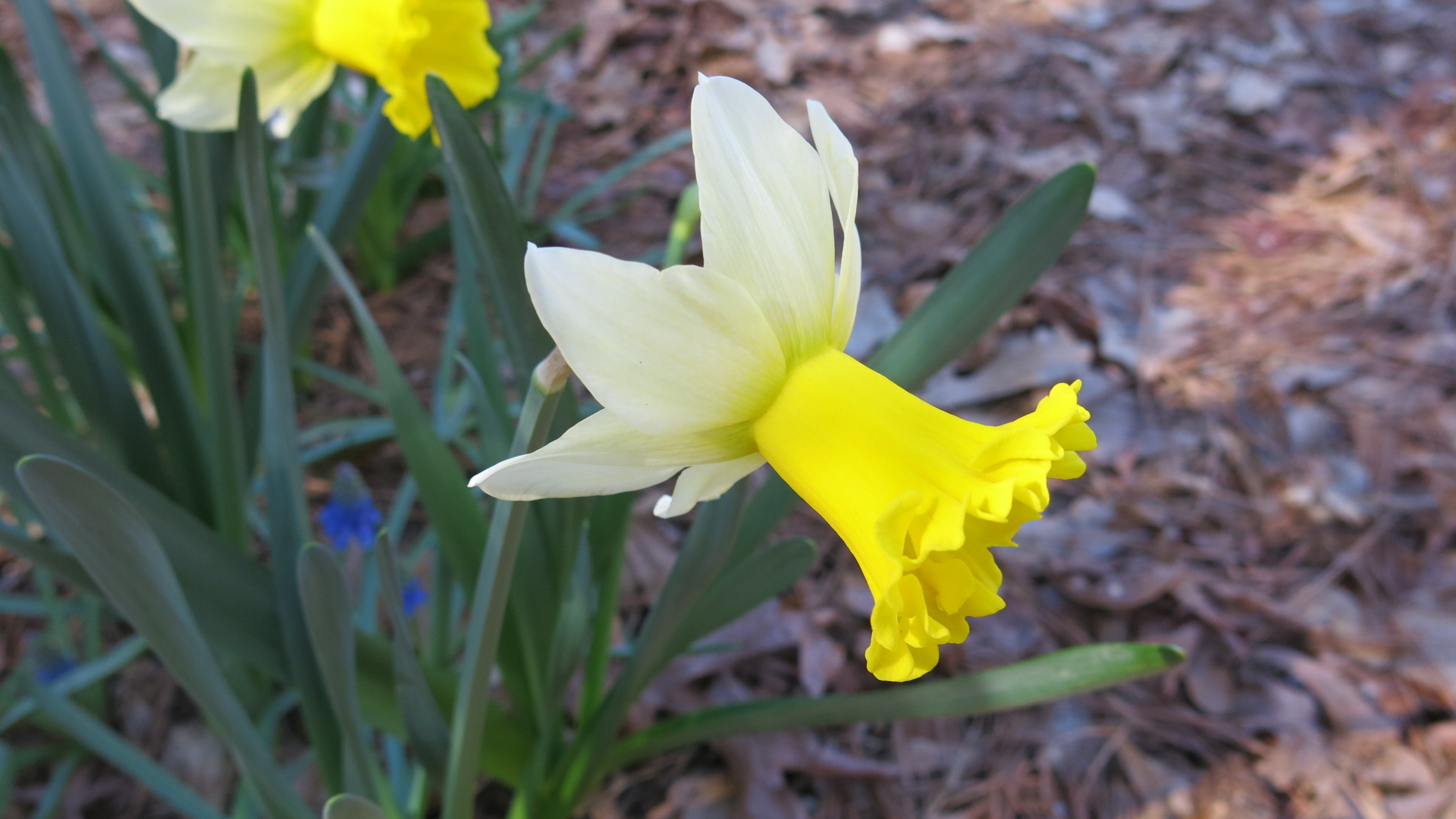 Narcissus 'Wisley,' a cyclamineus daffodil.
Narcissus 'Wisley,' a cyclamineus daffodil.Division 7: Jonquilla Daffodils
Jonquilla Daffodils-- Usually several flower heads to a stem, flowers usually fragrant, stem is round in cross-section and foliage is often rush like.
Examples: Baby Moon,
Bell Song, Kedron, New Baby, Pipit, Quail, Prosecco, Stratosphere, Sweetness, Sweet Smiles
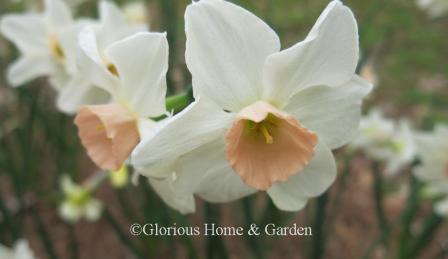 Narcissus 'Bell Song,' a jonquilla daffodil.
Narcissus 'Bell Song,' a jonquilla daffodil.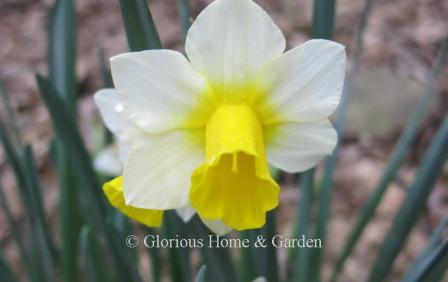 Narcissus 'Golden Echo,' a jonquilla daffodil.
Narcissus 'Golden Echo,' a jonquilla daffodil.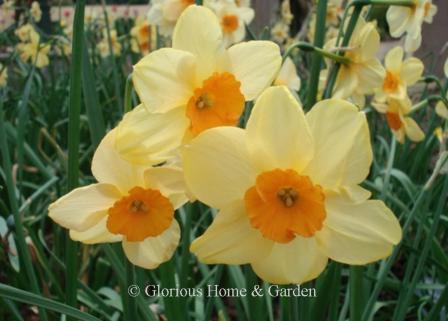 Narcissus 'Kedron,' jonquilla daffodil.
Narcissus 'Kedron,' jonquilla daffodil.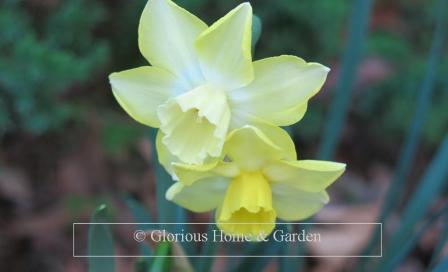 Narcissus 'Pipit,' jonquilla daffodil.
Narcissus 'Pipit,' jonquilla daffodil.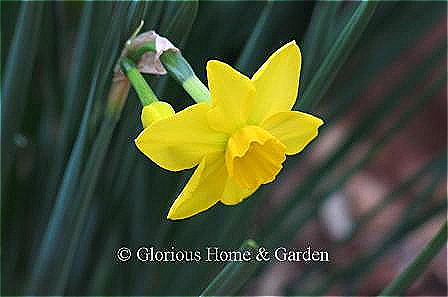 Narcissus 'Stratosphere,' jonquilla daffodil.
Narcissus 'Stratosphere,' jonquilla daffodil.Division 8: Tazetta Daffodils
Tazetta Daffodils-- Usually three to twenty flowers to a stout stem, sweet scented and very short cupped. Perianth segments rounded and often somewhat crinkled.
Examples: Aspasia, Avalanche, Canaliculatus, Cragford, Falconet, Geranium, Minnow, Silver Chimes
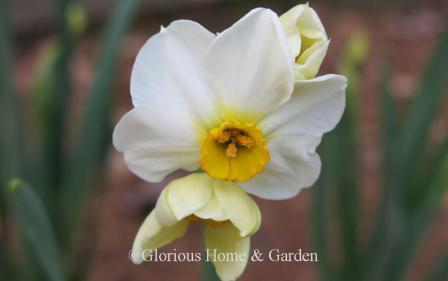 Narcissus 'Aspasia,' a tazetta daffodil.
Narcissus 'Aspasia,' a tazetta daffodil.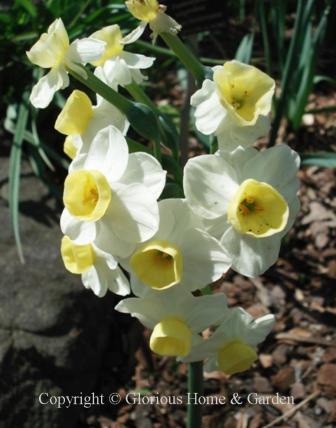 Narcissus 'Avalanche,' a tazetta daffodil.
Narcissus 'Avalanche,' a tazetta daffodil.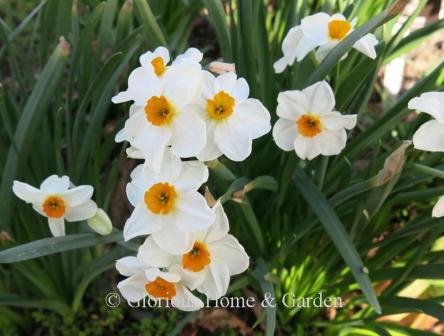 Narcissus 'Cragford,' a tazetta daffodil.
Narcissus 'Cragford,' a tazetta daffodil.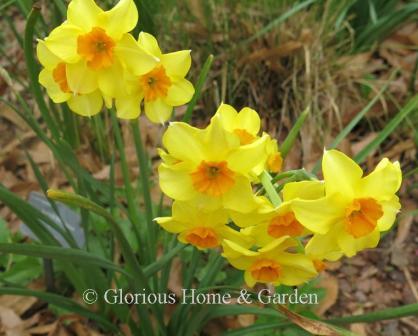 Narcissus 'Falconet,' a tazetta daffodil.
Narcissus 'Falconet,' a tazetta daffodil.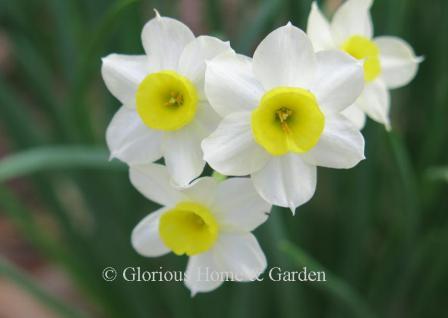 Narcissus 'Minnow,' a tazetta daffodil.
Narcissus 'Minnow,' a tazetta daffodil.Division 9: Poeticus Daffodils
Poeticus Daffodils-- Usually one flower to a stem. White petals sometimes stained with the corona color at the base, small flat cup edged with red. Fragrant.
Examples: Actaea,
Angel Eyes, Ornatus, Pheasant's Eye, Vienna Woods
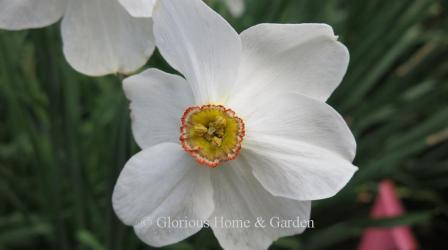 Narcissus 'Actaea,' a poeticus daffodil.
Narcissus 'Actaea,' a poeticus daffodil.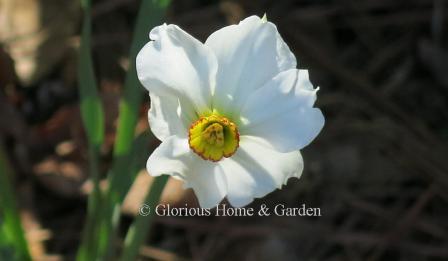 Narcissus 'Ornatus,' a poeticus daffodil.
Narcissus 'Ornatus,' a poeticus daffodil.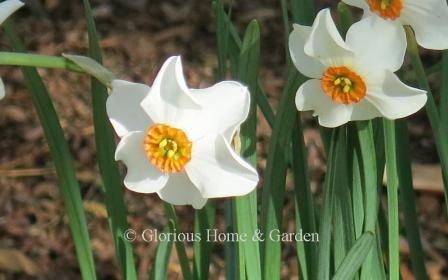 Narcissus 'Vienna Woods'
Narcissus 'Vienna Woods'Division 10: Bulbocodium Daffodils
Bulbocodium Hybrids-- Small flowers resemble a “hoop petticoat” form.
Examples: Golden Bells, Cornish Cream
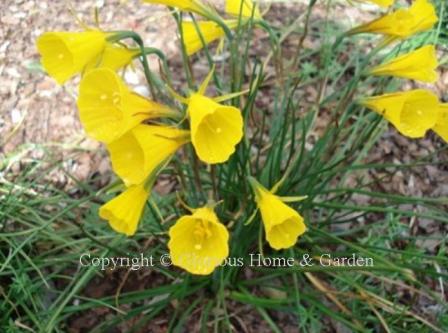 Narcissus bulbocodium, a bulbocodium group daffodil.
Narcissus bulbocodium, a bulbocodium group daffodil.Division 11a: Split-Cupped Collar Daffodils
Split-Cupped Collar Daffodils-- Split-corona daffodils with the corona segments opposite the perianth segments; the corona segments usually in two whorls of three.
Examples: Apricot Whirl, Blazing Starlet, Cassata, Edinburgh, Electrus, Exotic Mystery, Mallee, Mondragon, Orangery, Shrike, Tricollet
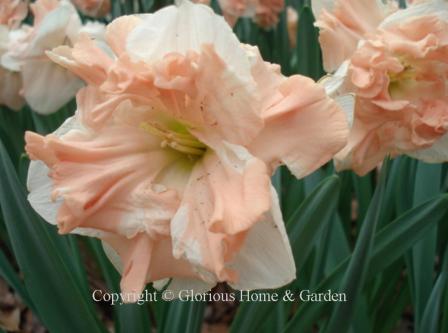 Narcissus 'Apricot Whirl,' a split-cupped collar daffodil.
Narcissus 'Apricot Whirl,' a split-cupped collar daffodil.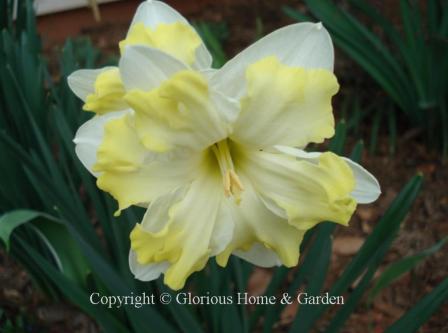 Narcissus 'Cassata,' a split-cupped collar daffodil.
Narcissus 'Cassata,' a split-cupped collar daffodil.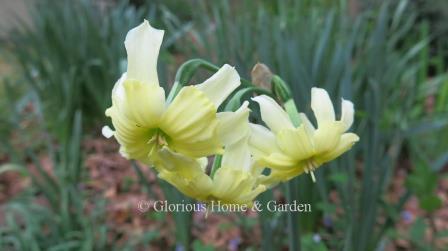 Narcissus 'Exotic Mystery,' a split-cupped collar daffodil.
Narcissus 'Exotic Mystery,' a split-cupped collar daffodil.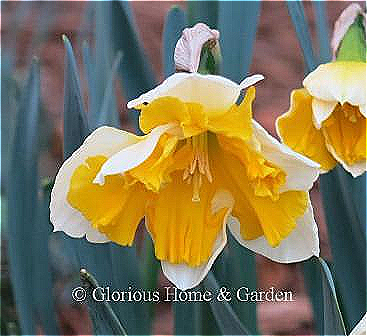 Narcissus 'Orangery,' a split-cupped collar daffodil.
Narcissus 'Orangery,' a split-cupped collar daffodil.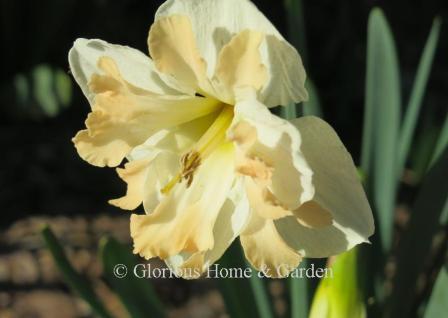 Narcissus 'Shrike,' a split-cupped collar daffodil.
Narcissus 'Shrike,' a split-cupped collar daffodil.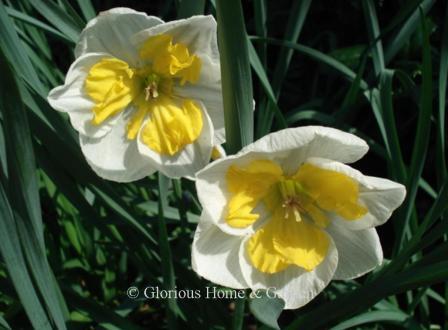 Narcissus 'Tricollet,' a split-cupped collar daffodil.
Narcissus 'Tricollet,' a split-cupped collar daffodil.Division 11b: Split-Cupped Papillon Daffodils
Split-Cupped Papillon
Daffodils: Split-corona daffodils with
the corona segments alternate to the perianth segments; the corona segments
usually in a single whorl of six. Also called butterfly daffodils.
Examples: Dancing Moonlight, Lemon Beauty, Papillon Blanc, Sorbet, Trepolo.
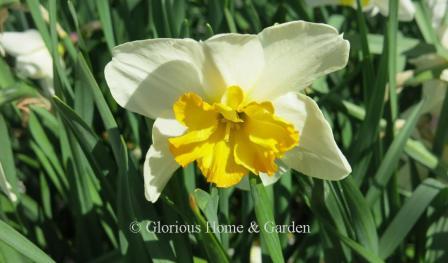 Narcissus 'Lemon Beauty,' a split-cupped papillon daffodil.
Narcissus 'Lemon Beauty,' a split-cupped papillon daffodil.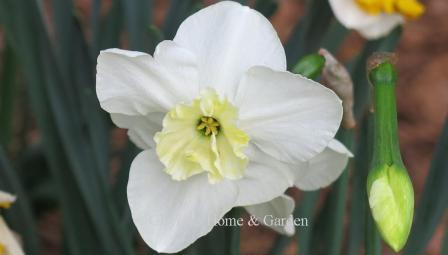 Narcissus 'Papillon Blanc' is a split-cupped papillon daffodil.
Narcissus 'Papillon Blanc' is a split-cupped papillon daffodil.Division 12: Miscellaneous Daffodils
Miscellaneous Daffodils-- Division 12 consists of daffodils not falling into any of the previous categories. Many are inter-division hybrids.
Examples: Bittern, Eaton, Song, Jumblie, Tête-á-Tête
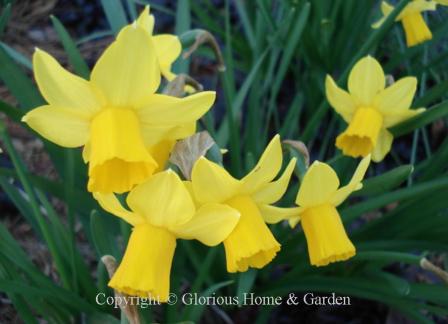 Narcissus ‘Tête-á-Tête,’ a daffodil from the miscellaneous class.
Narcissus ‘Tête-á-Tête,’ a daffodil from the miscellaneous class.Division 13: Species, Wild Variants and Wild Hybrids
Species, Wild Variants and Wild Hybrids--Division 13 consists of the wild, natural daffodils.
Examples: N. cantabricus, N. cyclamineus, N. jonquilla, N. jonquilla 'Simplex,' N. x medioluteus, N. moschatus, N. x odorus, N. papyraceus, N. poeticus var. recurvus
Narcissus bulbocodium subsp. bulbododium var. conspicuus
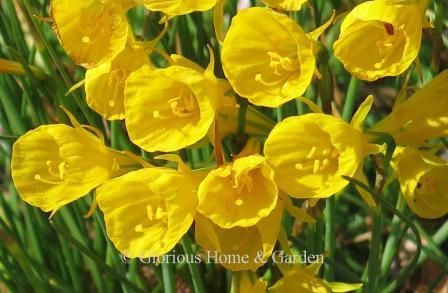
Narcissus jonquilla 'Simplex' is a tiny historical daffodil with bright yellow scented flowers. There are multiple flowers per stem. Charming!
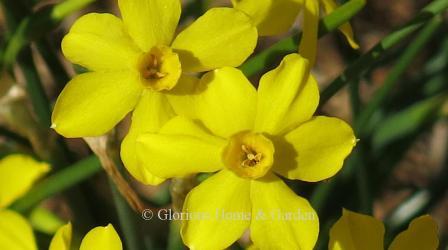 Narcissus jonquilla 'Simplex,' a species daffodil.
Narcissus jonquilla 'Simplex,' a species daffodil.Narcissus moschatus, is a lovely charmer also called Silver Bells or Swan’s Neck. The dainty creamy trumpet nods towards the ground on a curved stem and the petals are almost parallel to it. Goes beautifully with small bulbs like grape hyacinths or scillas.
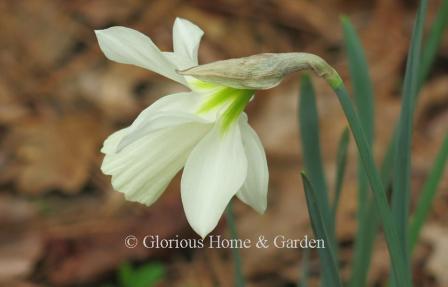 Narcissus moschatus, a species daffodil.
Narcissus moschatus, a species daffodil.Narcissus x odorus 'Linnaeus,' known as the campernelle, is single with a scalloped cup and twisty petals, also very fragrant and a great naturalizer
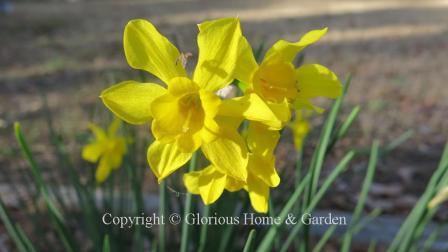 Narcissus x odorus 'Linnaeus,' a species daffodil.
Narcissus x odorus 'Linnaeus,' a species daffodil.Narcissus x odorus 'Plenus,' or 'Flore-pleno' is also called Queen Anne's double daffodil or the double campernelle, fragrant.
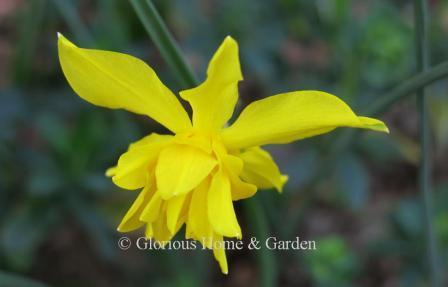 Narcissus x odorus 'Plenus,' a species daffodil.
Narcissus x odorus 'Plenus,' a species daffodil.Narcissus poeticus var. recurvus, is the old pheasant's eye daffodil, fragrant, with recurved petals and red-rimmed cup, late blooming
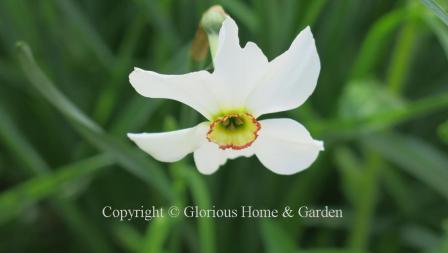 Narcissus poeticus var. recurvus, a species daffodil.
Narcissus poeticus var. recurvus, a species daffodil.Miniature Daffodils
Miniature Daffodils: Though not an official classification, it is helpful to group these smaller species and cultivars together as an aide in planning.
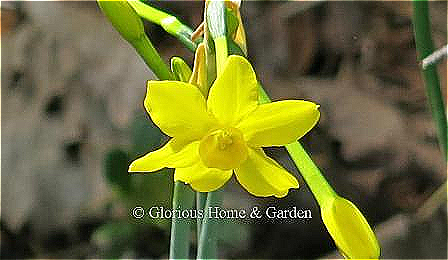 Narcissus 'Baby Moon,' a miniature jonquilla daffodil.
Narcissus 'Baby Moon,' a miniature jonquilla daffodil.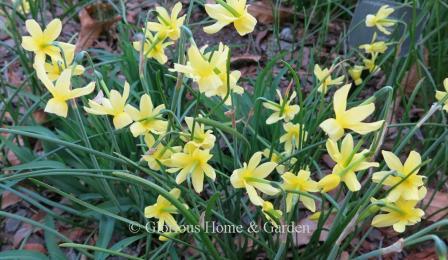 Narcissus 'Hawera,' a miniature triandrus daffodil.
Narcissus 'Hawera,' a miniature triandrus daffodil.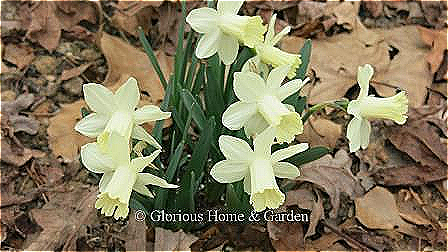 Narcissus 'Ice Baby,' a miniature trumpet daffodil.
Narcissus 'Ice Baby,' a miniature trumpet daffodil.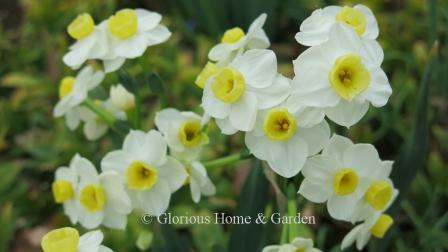 Narcissus 'Minnow,' a miniature tazetta daffodil.
Narcissus 'Minnow,' a miniature tazetta daffodil.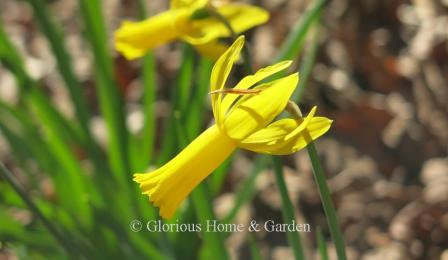 Narcissus 'Mite,'a miniature cyclamineus daffodil.
Narcissus 'Mite,'a miniature cyclamineus daffodil.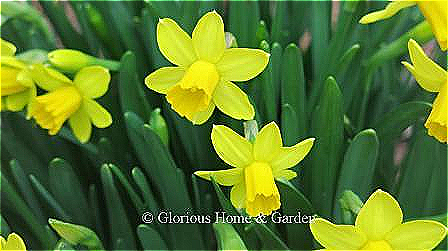 Narcissus ‘Tête-á-Tête,’ a miniature Division 12 daffodil.
Narcissus ‘Tête-á-Tête,’ a miniature Division 12 daffodil. Narcissus 'W. P. Milner,' a miniature trumpet daffodil.
Narcissus 'W. P. Milner,' a miniature trumpet daffodil.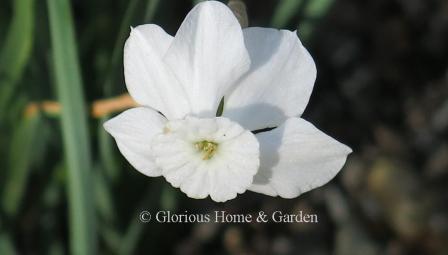 Narcissus 'Xit,' a miniature small-cup daffodil.
Narcissus 'Xit,' a miniature small-cup daffodil.For more information about daffodils, visit the American Daffodil Society at www.daffodilusa.org .
Plant of the Month
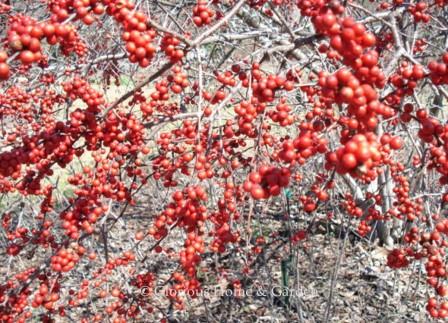
Ilex verticillata
Winterberry holly
Updated new USDA Plant Hardiness Zone Map 2023.